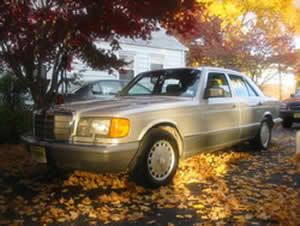 |
 |
 |
 |

|


|
|
|
|
|
|
#1
|
||||
|
||||
|
Hi folks! Just got back from state inspection and I failed for "brake balance". Specifically, the rear axle "difference left/right axle excessive" On the chart they gave me, the rear driver-side wheel has less brake (deceleration?) than the rear-passenger wheel - hence the failure. Front axle is OK as is the emergency brake.
Its a 91 300SE with just over 61K on it. Two years ago it had 59K on it and passed.  Not sure what it means, or what I should do beside take it in to my mechanic to look at. The brakes don't feel weird to me, but I guess something is astray. I'm just hoping to get some ideas here so I can have a semi-intelligent conversation w/ the mechanic, or maybe there is a simple thing I can do to adjust as needed? Thanks! |
|
#2
|
|||
|
|||
|
That NJ brake test is a wonder.
Check your tire pressures. I have found a good panic stop from 80mph can also help. |
|
#3
|
|||
|
|||
|
Do you know the condition of the rear pads? If not, that's the first step.
If the pads are good, you likely have a piston that's binding slightly in the LR caliper. This would warrant a replacement or rebuild of that caliper........and, normally, they are replaced in pairs, but, it's not mandatory. |
|
#4
|
|||
|
|||
|
Man that is low mileage!! Probably it is from lack of use! The panic stop and tire pressure ideas sound good. Also checking the pads. Obviously leaking fluid could cause less stopping force but you would probably be aware of that. That sounds like a wierd test. Maybe you could scuff up the discs with emery cloth? And maybe bleeding the rear might help if there is some air in there.
Mike
__________________
1998 C230 330,000 miles (currently dead of second failed EIS, yours will fail too, turning you into the dealer's personal human cash machine) 1988 F150 144,000 miles (leaks all the colors of the rainbow) Previous stars: 1981 Brava 210,000 miles, 1978 128 150,000 miles, 1977 B200 Van 175,000 miles, 1972 Vega (great, if rusty, car), 1972 Celica, 1986.5 Supra |
|
#5
|
||||
|
||||
|
Some interesting suggestions. Thanks!
Offhand, I'm not positive how the rear pads are except that there is no grinding sounds or any wear light on the dash indicating low material. I've assumed them OK (yes I know about assuming!), but I think I'll have a look-see. No fluid is leaking as far as I can tell. Reservoir is still full, and no fluid is around the wheels anywhere. Tires are properly inflated as far as I can tell, maybe I'll add a few pounds and try this panic-stop concept when I can do it safely somewhere. Yeah, its not my daily driver - yet. I've had it for a little over 2 years now and it stays in the garage for the most part except for some nice rides on the highway. I'm waiting for my 92 Nissan to die (198K miles) so I can replace it with an even older vehicle!  In the meantime, its a garage queen and looks like its off the showroom floor. Got several compliments today while waiting over an hour for inspection. Makes one wonder the pollution caused and gas burned by 100 idling cars in an effort to make sure they run clean. In the meantime, its a garage queen and looks like its off the showroom floor. Got several compliments today while waiting over an hour for inspection. Makes one wonder the pollution caused and gas burned by 100 idling cars in an effort to make sure they run clean.   Thanks guys. This site has always been a big help to me! |
|
#6
|
|||
|
|||
|
One method that I used to measure relative brake function, and that I have posted before, is to use temperature. The theory is that the disc (or drum) will heat up relative to the braking "amount". A test I did (starting with cold brakes) was drive about a mile and slow down relatively hard from 40 to 20 mph, about 4 times. Then I measured the disc temps. I used an IR thermometer but you could use your finger CAREFULLY and get a general idea. If the rear disc is cold then there is definitely a problem. be careful, those discs can get real hot! Especially if the caliper is seized!!
__________________
1998 C230 330,000 miles (currently dead of second failed EIS, yours will fail too, turning you into the dealer's personal human cash machine) 1988 F150 144,000 miles (leaks all the colors of the rainbow) Previous stars: 1981 Brava 210,000 miles, 1978 128 150,000 miles, 1977 B200 Van 175,000 miles, 1972 Vega (great, if rusty, car), 1972 Celica, 1986.5 Supra |
 |
| Bookmarks |
|
|